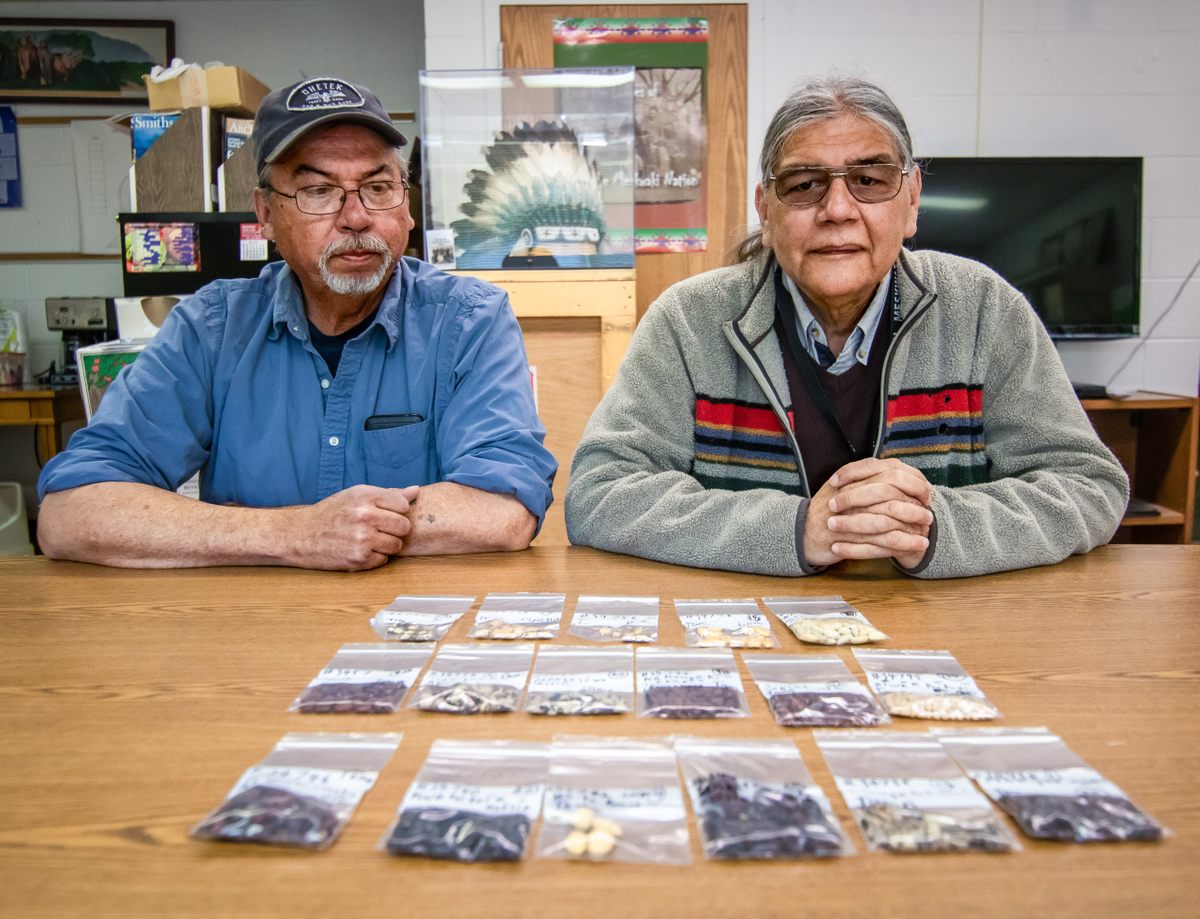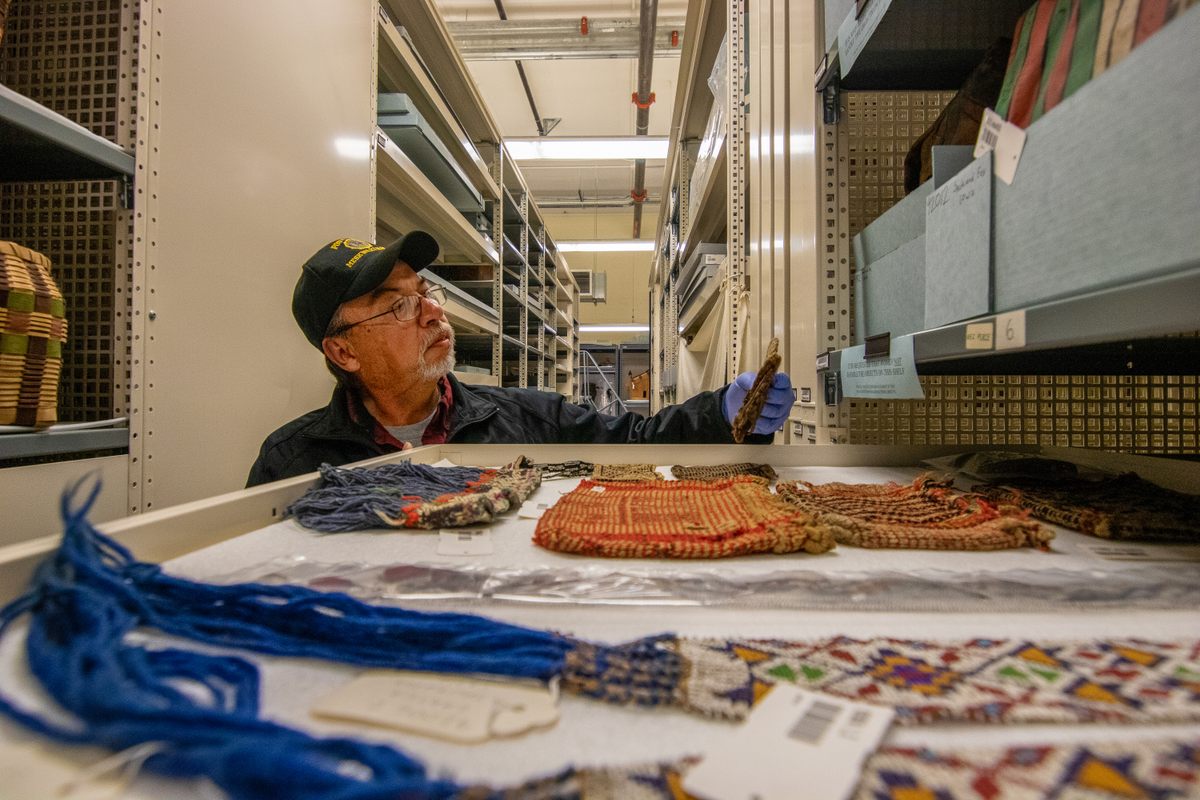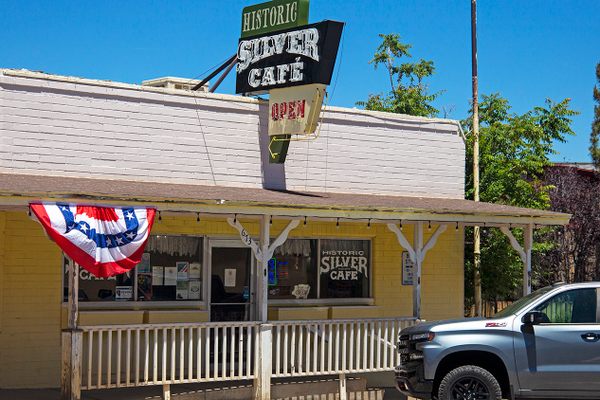Centuries After Their Loss and Theft, Native American Seeds Are Reuniting With Their Tribes
They are being recovered from seed banks, university vaults, and museum shelves.
The squash had traveled a thousand miles to rest quietly on Henrietta Gomez’s arms. The elder farmer from Taos Pueblo, a 1,000-year-old Indigenous town in northern New Mexico, held the light-green vegetable like a baby. Before that bright October morning, it had been several decades since the people of Taos Pueblo had seen a squash like the one in Henrietta’s arms, even though it had been part of the town’s diet since time immemorial.
Along with a seed bundle, the squash had been shipped from Decorah, Iowa, where it had been planted in the gardens of Seed Savers Exchange, the nonprofit that found the variety among the 30,000 kinds of seeds in its seed bank. Rowen White, an Indigenous seed keeper and the chair of the nonprofit’s board, had personally shipped the giant seed-and-squash-filled box a few days before.
The Taos Pueblo event, held in 2018, was the first of at least 60 rematriations organized by the Indigenous Seed Keepers Network that have returned varieties of ancient seeds to Native American communities that had been lost to colonialism and violence.
“To us, seeds are our relatives,” says White, who was born near Canada in the Mohawk community of Akwesasne. In 2016, she created the Indigenous Seed Keepers Network, a group of more than 100 tribal seed-sovereignty projects whose members are looking for their missing relatives. (They refer to the act of returning Native seeds as rematriation rather than repatriation.) The network has found 1,000 varieties linked to Native American tribes in the Seed Savers Exchange catalog, a nonprofit and seed bank created in the Seventies that now has one of the largest seed catalogs in the country. Every year since, they’ve rematriated around 25 varieties.

“People want to be connected to the seeds because it’s a way of connecting them to their ancestors, the seed keepers who initially developed them,” says Dr. Elizabeth Hoover,* an associate professor of Environmental Science and Policy Management at UC Berkeley. It’s also a way, White adds, to heal racist wounds inflicted on Native American food systems.
The ties that bound Native seeds to Indigenous communities began to be severed when the first European settlers arrived, and it continued for centuries. It partially grew out of the tactic—widely used by European settlers, and later by U.S. government officials—to take Indigenous land by attacking tribes’ food sources. In the northeast, the French Marquis de Denoville destroyed the corn crops of the Haudenosaunees in 1678. A hundred years later, in 1779, Major General John Sullivan and his army, under the orders of George Washington, burned the Haudenosaunees’ crops. “That’s why in most Haudenosaunee languages, the word for president means ‘town destroyer,’” Hoover explained in late 2019.
In the Southeast, the Indian Relocation Act of 1830 forced around 100,000 Indigenous people from five tribal nations out of their homelands. Indigenous communities not only were forcefully separated from their land, but from many of their seeds, says Deb Echo-Hawk, a Pawnee seed keeper in Oklahoma. An estimated 15,000 Indigenous people from various nations died of disease and other causes during these forced marches. So many elderly seed keepers fell ill without passing on their knowledge that they often put their precious seed bundles in trees to “give them back to Aitius [the Creator] because there wasn’t anybody left that knew how to take care of them,” Echo-Hawk says.
But Native Americans didn’t find peace in their new lands. Accustomed to the wet and cold Nebraska soil, Pawnee traditional seeds wouldn’t grow in the red-clay soil of Oklahoma, says Echo-Hawk. (It was only in 2005, when the tribe allied with a Nebraska farmer, that they could taste again 18 traditional corn varieties). Treaties such as the 1887 Dawes Act, which divided Indigenous lands into lots that were mostly sold to white farmers, also reduced the ability of tribes to grow their own food and plant their seeds.
By the 1930s, these policies had displaced two-thirds of Native people from their traditional lands, with very few of those unfamiliar acre-lots to call their own, which meant they had no place to grow traditional foods, says Noah Schlager, a seed keeper of Mvskoke-Creek and Catawba heritage. In addition, between 1860 and 1978, government-funded American Indian Boarding Schools, whose goal was assimilation, prohibited Indian languages and names and cut students off from the generational passing down of Native American culture, including their foodways.
In the early 1900s, the continuous attacks on Native American communities had left many in such a fragile state that many anthropologists assumed that they would disappear, says Hoover. This pushed Native and non-Native anthropologists and museum curators to collect the Indigenous seeds that are now dormant on the shelves of museums and universities. In the 1970s, when industrialized farming was at its prime, environmentalists and farmers also started to realize the dangers of genetically uniform crops. Without diversity, a single plague could destroy thousands of miles of the same plant, wrote science historian Helen Curry. So they created seed banks, whose contents included Native seeds.
But “the founders of these seed banks didn’t completely respect the sovereignty of Native communities,” says Schlager, who works as conservation manager at Native Seeds/SEARCH, one the biggest seed banks of Native American seeds in the country. “Sometimes, they would just buy seeds in a market and didn’t [tell] the Native farmer that they wanted to keep them for seed banks.” The “white-savior mentality” behind the creation of many of these seed banks, says Schlager, didn’t do anything to help struggling Native American food systems.

In the late 1970s, alongside the Civil Rights movement, Indigenous communities across the country started organizing to address their land rights and other cultural and social issues. This eventually gave birth to an incipient Indigenous food movement, says Clayton Brascoupé, who in 1992 founded the Traditional Native American Farmers Association. In those early days, says Brascoupé, many Native farmers didn’t know where or how to find their traditional seeds. Farmers would first try to find the missing varieties in their local communities. They’d write letters to nearby farmers, Native and non-Native, who gave them leads to people even further away. “And it was just this natural progression, you keep looking, and looking, and looking,” the Mohawk-Anishinaabeg farmer says.
By the late 2000s, Native farmers had cast their investigative nets so wide that they were all talking to each other, exchanging seeds, and planning food summits. The Indigenous Seed Keepers Network formalized those relationships, says its director, Rowen White. Two years later, the network was celebrating the rematriation of the Native Taos Pueblo squash that is now growing and producing offspring in several farms of the community.
But seeds don’t always enjoy a gentle, almost ceremonial way home. For those that have not been stored in seed vaults with controlled temperature and humidity, returning to their community may mean finally going back to rest under the earth.
That’s what happened to the 12 bags of Mekswaski seeds that Shelley Buffalo received in the spring of 2019. A few months earlier, Buffalo had received a phone call from Elizabeth Hoover. She told Buffalo that she was working with the Field Museum of Natural History in Chicago, and that she had found a collection of Meskwaki seeds hidden in the shelves of the Anthropology collection. The seeds had been there for a century, and that’s where they would have stayed if it wasn’t for Hoover.

“When I first brought up this idea [of rematriating the seeds], everybody at the museum looked at me like I was crazy,” says Hoover. “They were like, ‘This is a museum. It’s not a seed bank. That’s not how it works here. You can’t take things out of the collections and bury them!’” Hoover slowly convinced people that a rematriation would make an incredible story for the renovated North America Hall that she was helping to create. Soon, everyone was on board.
But even after convincing her peers, the administrative hurdles of deaccessioning, or taking something out of a museum permanently, are formidable. Repatriating objects to tribes is a process that can take months, says Eli Suzukovich, a research scientist at the Field Museum and a professor at Northwestern University. So instead, they filled out the paperwork to take out the seeds as part of a “destructive analysis,” a type of research that allows scientists to take objects out of a collection without bringing them back.
The strategy worked. A week later, Suzukovich drove to Tama, Iowa, to give Shelley Buffalo nine varieties of traditional beans and three types of corn. Some of them hadn’t been in the community for years, while others were well-known varieties. The seeds were so old, says Buffalo, that she had a hard time recognizing the Meskwaki corn, a variety that she has planted over and over again as the coordinator of the local foods branch at the Meskwaki Food Sovereignty Initiative.
Shelley and other farmers tried their best to wake up the seeds. They left some soaking up water overnight, as tradition calls for, and an organic farmer in the community used a germination method he had developed on others. They planted the seeds “hopeful that the miracle would happen, but at the same time with a pragmatic mindset,” Buffalo says.
None of the seeds sprouted. “But I didn’t care,” Buffalo says, “It was just the fact that they were back with us.”

Despite the bitter first try, Suzukovich kept digging. In the drawers of the ethnobotany collection, he found a whole new section of Meskwaki seeds. Since the ethnobotany collection is designed to store plants and seeds, the century-old cobs still had that sweet, earthy smell of fresh corn.
The plan to bring some of those seeds back to Tama was put on hold due to the pandemic, but the scientific team led by Suzukovich hopes to restart conversations and revive the seeds using methods agreed on with the Meskwaki for the 2021 growing season. “We are really excited. We have seeds that are a hundred-plus years old from various plants. If this is successful, then it helps us to think about conservation efforts at large,” he adds.
“It’s just really interesting seeing the kind of dynamics developing between this big museum, which has historically just held on to the possessions of different communities, and is now giving some of these back,” says Hoover. Only two museums—the Field Museum and the Science Museum of Minnesota—have rematriated seeds. But, according to Hoover, others are interested, as well as some universities.
Earlier this year, Seed Savers Exchange reached out to Shelley Buffalo and told her that they had found several Meskwaki varieties in their vault. “It’s like the seeds have their agenda,” says Buffalo. “If you look at what’s going on with the pandemic, if you are looking at what’s going on with the political unrest, and then also in the longer term with climate change. It’s like they are saying, ‘It’s time to go home and time to reconnect with our people because our people are going to need us.’”
* Update 11/2/22: This article previously identified Hoover as having Micmac and Mohawk ancestry. However, Hoover recently withdrew her claim to that identity. Gastro Obscura has removed the mention of her ancestry, is reviewing her other comments, and will update as necessary.
Gastro Obscura covers the world’s most wondrous food and drink.
Sign up for our regular newsletter.
This story originally ran in 2020; it has been updated for 2022.





































Follow us on Twitter to get the latest on the world's hidden wonders.
Like us on Facebook to get the latest on the world's hidden wonders.
Follow us on Twitter Like us on Facebook